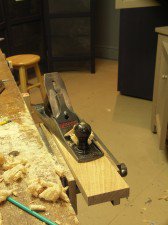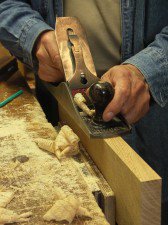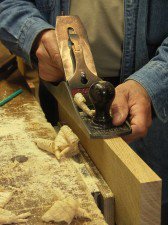Sensing your plane work
I traced my fingers over the planes in the shop this morning. Working on the plane book is rejuvenating and I should have published it years ago when I first wrote it. I think that am improving it because of my increased understanding of you. A book I really enjoy was written by Aldren Watson a long time ago and just came back on the market after a brief lapse. His drawings are quite incredible and sensitive. I’d like to rework the format into a coffee table edition and add some of my photographs.
It was pleasant to be back in the workshop today. A sense of normality and sanity if you like. Next week I have a full week of teaching so this week we prepare for that. My creative workspace feels settled to me. A place I can invest my time and write to you about my work.
I used my Sorby 5 1/2 to foursquare some oak for my new project. This plane is superb to use for straightening and flattening. I also used a Veritas low-angle bench plane, which physically presents the length of the iron in more of an in-line direct force against the opposing grain so that the strength and power of the heel of the hand is optimized.
See how my left hand relaxes to the whole planing movement. It flexes and moves loosely with the plane. The hand position here may change as you can see. Beneath, where you cannot see, my forefinger, centre digit, beneath the second knuckle, traces the wood below and guides me. I like this. It’s important to me too.
I often see woodworkers, most of them actually, not just an occasional one, holding the plane with a death-throttle grip; especially the fore knob, but generally the knob and the tote. This is a rarity for me. My fingers trace the board beneath the sole of the plane as I pass forward mid-motion. My right-dominant power hand delivers the plane to task and, or should I say, AND, flexes the plane according to my feelings within my motion. My left hand also transmits through my senses whilst similarly supporting the plane and adding lateral inflections in split second by split second response. I rely on this information to correct my course and direct my energy. These are things you must know by learning not my telling. I tell only that you might try, do and discover and know that you don’t know so that you might seek to know relationally by the working of it. You should take time to listen, feel and look to what you are doing to and with the wood and the tool as it relates to the work. This heightens sensitivity and awareness to bring fullness in the maximised efficiency of what you do with your planes.





Reading through Aldren A. Watson’s “Hand Tools” I was reminded of the books by Eric Sloane such as “A Museum of Tools” & “Our Vanishing Landscape”. The following link will take you to the Amazon page for his books where you can read excerpts.
Yes, I enjoyed Eric Sloane’s work from years ago when I bought his books for my children. They are good reference books too.